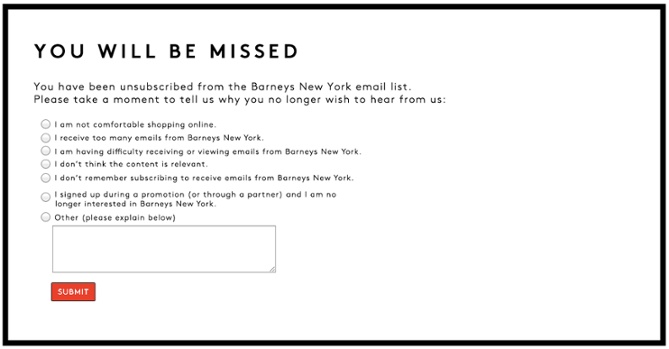As a digital marketer or entrepreneur, when was the last time you communicated with your customers?
If your answer was, “Last week - I constantly monitor feedback from customers,” bravo! You probably realize the value of customer feedback and how it can benefit your business.
If your answer was, “I never communicate with our customers, but since you asked that question I feel like I should be,” then yes, you’re right. You should be.
Digital marketers tend to be very data-driven, focusing on analytics and metrics like CPC, CPA, CPM, etc. CEOs like to focus on the bottom line. But hold on, data nerds and financial fiends. Take a step back from the numbers for a minute. Instead of thinking of users as nameless, faceless traffic sent to your site, think of them as actual people with stories and a unique perspective.
After all, customers are the bloodline of a company. No customers = no revenue = no business.
Don't just listen to customer feedback. Leverage it.
In order to take the pulse of your business, start listening to what your customers are saying. And if you want to be a truly successful business, you need to not only listen to customer feedback, but you also need to leverage it to guide future campaigns and improve products, services and overall customer experience.
One of the most common mistakes among both digital marketers and entrepreneurs is failing to gather feedback consistently throughout their business’s or client’s lifespan. Don’t wait for a problem to arise before you start getting feedback from your customers - it’s always better to be proactive rather than reactive.
If you aren’t currently gathering feedback, it’s never too late to start. When beginning the process of gathering user feedback, consider the following questions:
- What is our goal in gathering user feedback?
- What are we trying to learn about our users?
- What are we trying to improve?
- What will we do with the data/insights we collect?
Once you’ve worked through these questions and have a clear purpose for gathering user feedback, do some research and determine what channel will be most effective in accomplishing your goal.
For instance, if you’ve noticed that a lot of your site’s users are unsubscribing from your email list and you want to uncover why, create an unsubscribe survey. Here is an example from Barney’s New York:

Credit: Hubspot
This is a relatively simple way to gather feedback about email marketing campaigns. There are dozens of ways to gather user feedback, ranging from relatively simple tactics, like this unsubscribe survey, to more time-consuming strategies, like in-person interviews.
Here are some effective ways to gather user feedback:
- Email/Contact forms
- Surveys
- Help tickets
- Review sites
- Blog post comments
- Social platforms
- Phone interviews
- In-person interviews
- Focus groups
- Cancellation surveys
- Website visitor activity
Below I’ve highlighted a few real-world examples of how to gather user feedback using three of these channels, and how to implement the feedback to guide future marketing or business decisions.
Example 1: Monitor Review Sites
One of the easiest ways to collect user feedback is to monitor review sites, such as Yelp, TripAdvisor, or whichever review site may be applicable to your company or industry. In most cases, customers post reviews if they are either very happy or very upset with a product or service; both insights are equally important.
At Brolik, we use this method of gathering user feedback for a client in the fine dining industry. Specifically, we monitor Yelp and TripAdvisor for customer reviews every few days. The restaurant has recently undergone major changes in management, pricing and menu, so it is an especially critical time to listen to what customers are saying.
Over the course of a couple months, we started to see a trend in the reviews - customers enjoyed the food, but they were disappointed with certain aspects of the service, and the fact that they could not call the restaurant to make a reservation.
In response to the feedback, the phone number was added to the site, and we communicated the recurring service complaints to the owner of the restaurant, so he could work through the issues with the staff.
Example 2: Social Platforms
Another simple and obvious way to gather user feedback is to monitor social platforms. You can get a really clear idea of what your customers are thinking by looking at their comments, what content they like and what they share. In addition to monitoring everyday comments, tweets, etc., you can also pose open-ended questions to your social network asking for their feedback or ideas.
For example, “Hey friends, we would love to get some feedback from you. What is something we don’t offer that you would like to see?” Or, more generally, “How would you describe us in 3-5 words?”
Asking questions like this allows you to learn what users think about your brand, shows customers that you value what they have to say and it also gives you the opportunity to learn the lexicon your customers are using so you can incorporate it into your messaging.
Here is an example from Skype:

Credit: Skype on Facebook
Another way to gather feedback on social networks is to go the Who Wants to Be A Millionaire route and poll the audience. Twitter has a polling feature built into the platform where you can ask your followers a question with up to four answers.

Credit: Brolik on Twitter
Using the example poll above, we can learn which topics Brolik’s Twitter followers like to read about, and then curate our next piece of content or blog post around that topic. Facebook recently removed its built-in polling feature, but you can still create and post poll questions through a third party service/app.
While you shouldn’t use social polls if you want detailed responses about multiple questions, they are a great way to get simple answers to time-sensitive questions.
Example 3: Phone Interviews
As I mentioned earlier, digital marketers and entrepreneurs tend to rely heavily on quantitative data, but qualitative data is equally as valuable to gain insight into customers’ psyches.
Phone interviews may seem archaic in today’s tech-centric world, but talking to users directly is a great way to get feedback in a very authentic and personable way. I recently conducted phone interviews for one of my client accounts in order to gain user feedback.
Here is a little background:
The client is a startup, and our overall marketing goal was first to get users to create free accounts on our client’s site, then eventually
purchase a paid service. We reached a point in the campaign where we were sending a significant amount of quality traffic to their site using targeted search ads, display ads, retargeting ads and social posts. Over the course of two and a half months we sent approximately 17,000 users to the site, resulting in 2,000 free sign ups, but only 9 paid accounts (.0005% of site visitors converted into paid accounts; an extremely low conversion rate).
At this point, red flags started waving, so we started to dig into site analytics.
Based on the quality metrics we dug up (low bounce rate, 3:00 avg. session duration, high click-through rate) and the targeting on all of the ads, we could confidently say that we were sending the right audience to the site. So why were people not purchasing the paid service? Was it a product market fit issue? UX issue? Unclear website copy?
We determined that a pivot in our strategy might be necessary. Our first step was getting to the root of the problem; we needed to speak directly to our users and ask about their experience with the brand to determine why they were not buying the product. Based on our goal, we determined that phone interviews would provide the best insight.
Phone interviews are time-intensive. I won’t go into too much detail about the process, but I’ve laid out the steps I took below:
- Determined the goal for conducting the user interviews.
- Drafted a list of interview questions based on our goal.
- Gathered a list of confirmed user emails.
- Decided upon an incentive to entice users. In this instance, we offered a $25 Visa gift card to those who agreed to speak with us.
- Drafted multiple versions of the email and subject lines in order to A/B test the emails to determine which email led to the greatest volume of responses.
- Sent batches of 25-50 emails per day.
- Used a scheduling tool to easily gather users’ full names and phone numbers, and to schedule an interview time.
- Recorded and/or took notes during every phone interview.
- Made note of key takeaways immediately following each interview so I didn’t forget details I may want to revisit later.
- Sent follow-up emails thanking the users.
- Analyzed the feedback to identify common themes, and then sent the findings and our interpretation of the findings to the client.
Make the Most of User Feedback
Conducting the user interviews was only the first step of the equation. After talking with the users, we analyzed the feedback and identified common pain points across the users.
In this instance, I identified three common pain points:
- Users were confused about the brand’s identity and service offerings.
- Users in our audience were not tech-savvy - they didn’t understand how to use the products.
- A majority of the users thought the product was too expensive.
Although this information was hard for our clients to hear, it was crucial in determining the next steps for the business. Bill Gates said, “Your most unhappy customers are your greatest source of learning.” Amen, Bill.
By conducting phone interviews, we got to the heart of why users were not buying the product. We can now use this feedback to clarify the brand identity, create step-by-step guides on how to use the product and re-evaluate the price of the product.
All of this being said, there is one caveat. While you should listen to your customers and try to make them happy, you cannot let customer feedback completely guide the future of your company.
For example, if users are having a major issue with the cost of your product, that is obviously not an easy fix. The price of a product is set for a reason, and you can only change it so much without damaging the company’s bottom line. Gather feedback and use it to implement changes in a strategic and useful way.
Make Customer Feedback a Priority
As I said earlier, you can use feedback to guide future campaigns, improve products, services and overall customer experience. And on a larger scale, user feedback can be the starting point for a major pivot in your business strategy or marketing campaigns. You might want to see here now for more info on customer research insights.
For marketers and entrepreneurs alike, customer feedback is a gold mine of knowledge, and it’s important to tap into it consistently throughout the lifespan of your business or campaign.
What other methods have you used to gather quality customer feedback? Tell me in the comments!
